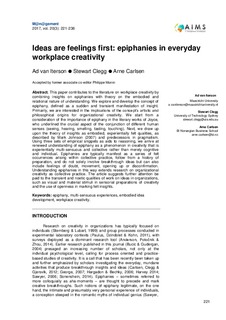Ideas are feelings first: epiphanies in everyday workplace creativity
Journal article, Peer reviewed
Published version
Permanent lenke
http://hdl.handle.net/11250/2465847Utgivelsesdato
2017Metadata
Vis full innførselSamlinger
- Publikasjoner fra CRIStin - BI [1015]
- Scientific articles [2181]
Originalversjon
M@n@gement. 2017, 20 (3), 221-238.Sammendrag
This paper contributes to the literature on workplace creativity by combining insights on epiphanies with theory on the embodied and relational nature of understanding. We explore and develop the concept of epiphany, defined as a sudden and transient manifestation of insight. Primarily, we are interested in the implications of the concept’s artistic and philosophical origins for organizational creativity. We start from a consideration of the importance of epiphany in the literary works of Joyce, who underlined the crucial aspect of the conjunction of different human senses (seeing, hearing, smelling, tasting, touching). Next, we draw up upon the theory of insights as embodied, experientially felt qualities, as described by Mark Johnson (2007) and predecessors in pragmatism. Using three sets of empirical snippets as aids to reasoning, we arrive at renewed understanding of epiphany as a phenomenon in creativity that is experientially multi-sensuous and collective rather than merely cognitive and individual. Epiphanies are typically manifest as a series of felt occurrences arising within collective practice, follow from a history of preparation, and do not solely involve breakthrough ideas but can also include feelings of doubt, movement, opening up or disconfirmation. Understanding epiphanies in this way extends research on organizational creativity as collective practice. The article suggests further attention be paid to the transient and noetic qualities of work on ideas in organizations, such as visual and material stimuli in sensorial preparations of creativity and the use of openness in marking felt insights.
